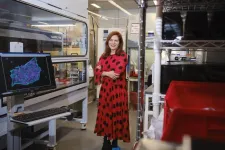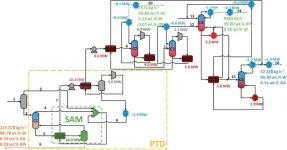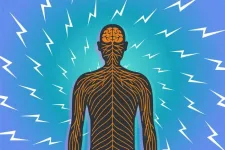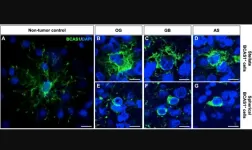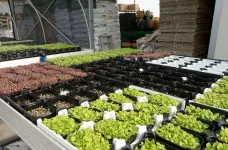(Press-News.org) Rickets ran rife in children following the Industrial Revolution, but University of Otago-led research has found factory work and polluted cities aren’t entirely to blame for the period’s vitamin D deficiencies.
In a Marsden funded study, just published in PLOS One, researchers from Otago, Durham University, University of Edinburgh, University of Brighton, and University of Queensland, sampled teeth from a cemetery site in industrial era England, looking for microscopic markers of nutritional disease.
Lead author Dr Annie Sohler-Snoddy, Research Fellow in Otago’s Department of Anatomy, says they uncovered some of the first clear evidence of seasonal vitamin D deficiency in an archaeological sample.
She says it has been known for many years that there was an increase in rickets, a childhood bone disease caused by vitamin D deficiency, in 18th and 19th Century Europe.
“It has been assumed that this was due to more people, including children, working long hours indoors, living in crowded housing and in smog-filled environments, all of which reduce the amount of sunlight that reaches a person’s skin, which is the main way humans make vitamin D.”
However, new bioarchaeological methods enabled the researchers to get a much clearer picture of how vitamin D deficiency affected the people living in industrial England, rather than looking at bone deformities alone.
The study found markers associated with vitamin D deficiency in the interior part of 76 per cent of the teeth analysed. In many samples, these occurred regularly, in annual increments.
“This shows clear evidence of seasonal vitamin D deficiency in the teeth of people living in the north of England.
“This is exciting because it highlights that latitude and seasonal lack of sunlight was a major factor in the amount of vitamin D these people could make in their skin – it’s more complicated than the factors associated with the industrial revolution like working indoors more,” Dr Sohler-Snoddy explains.
Poor vitamin D status is associated with several negative health outcomes including increased risk for infectious diseases, cardiovascular disease, and cancers.
Vitamin D deficiency has been an ongoing problem in society and Dr Sohler-Snoddy believes it is important to study what happened in the past in order to inform modern approaches to the ailment.
“We tend to think of archaeological human remains as belonging to a different world, but our biology hasn’t changed in the last 200 years.
“Teeth provide a really important source of information for archaeologists as they form in a very precise chronology and, importantly, their tissues do not change over the lifespan. This means that they lock in a record of a person’s development and this stays with them until they die, or the tooth is lost.
“Understanding how vitamin D deficiency impacted past populations and why gives us an important deep-time perspective on the disease,” she says.
END
Archaeological evidence of seasonal vitamin D deficiency discovered
2024-01-31
ELSE PRESS RELEASES FROM THIS DATE:
Jennifer J. Raab named President and CEO of The New York Stem Cell Foundation
2024-01-31
NEW YORK, NY (January 31, 2024) – The New York Stem Cell Foundation (NYSCF) announced today that, following a nationwide search, its Board of Directors has named Hunter College President Emerita Jennifer J. Raab as its next President and Chief Executive Officer, effective this month.
NYSCF is one of the world’s leading nonprofit stem cell organizations, raising and investing more than $450 million since its founding in 2005 to accelerate cures for the major diseases of our time through stem cell research. The foundation conducts its own pioneering research at the NYSCF Research Institute laboratories in Manhattan, informs and convenes scientists and ...
A new way to visualize brain cancer
2024-01-31
Brigham and MIT researchers uncovered never-before-seen details in human brain tissue with new, inexpensive microscopy technology.
KEY TAKEAWAYS
Researchers have developed a new microscopy technology called decrowding expansion pathology (dExPath) to analyze brain tissue.
By pulling proteins apart with dExPath, researchers can stain proteins in tissue that could not be accessed before, highlighting nanometer sized structures or even cell populations that were previously hidden.
This “super-resolution imaging” technology ...
AI can predict brain cancer patients’ survival
2024-01-31
Artificial Intelligence (AI) can predict whether adult patients with brain cancer will survive more than eight months after receiving radiotherapy treatment.
The use of the AI to successfully predict patient outcomes would allow clinicians to be better informed for planning the next stage of treatment and refer patients to potentially life-saving treatment quicker.
This is the first use of AI to predict short-term and long-term survivors within eight-months of radiotherapy.
The paper published recently in Neuro-Oncology shows how researchers ...
Fermentation revolution? Trash becomes treasure as bio-waste yields valuable acetone and isopropanol
2024-01-31
In a major stride towards sustainable industrial fermentation, a team of researchers at Delft University of Technology (TU Delft) in The Netherlands, has unveiled pioneering advancements in the purification of isopropanol and acetone from the fermentation of waste gases. The study, published in SCI's Journal of Chemical Technology and Biotechnology, introduces novel processes that promise to elevate the efficiency and viability of large-scale production.
Isopropanol and acetone have a combined global market of $10 billion. Both chemicals are important industry solvents and isopropanol ...
The hottest catalog of the year: the most comprehensive list of slow-building solar flares yet
2024-01-31
Solar flares occur when magnetic energy builds up in the Sun’s atmosphere and is released as electromagnetic radiation. Lasting anywhere from a few minutes to a few hours, flares usually reach temperatures around 10 million degrees Kelvin. Because of their intense electromagnetic energy, solar flares can cause disruptions in radio communications, Earth-orbiting satellites and even result in blackouts.
Although flares have been classified based on the amount of energy they emit at their peak, there has not been significant study into differentiating ...
Researchers uncover potential non-opioid treatment for chronic pain
2024-01-31
Among the most difficult types of pain to alleviate is neuropathic pain, pain that is usually caused by damage to nerves in various body tissues, including skin, muscle and joints. It can cause patients to suffer feelings like electric shocks, tingling, burning or stabbing. Diabetes, multiple sclerosis, chemotherapy drugs, injuries and amputations have all been associated with neuropathic pain, which is often chronic, sometimes unrelenting and affects millions of people worldwide. Many of the available pain medications are only moderately effective at treating this type of pain and often come with serious ...
John Theurer Cancer Center (JTCC) physician co-authors clinical research on innovative oral leukemia therapy
2024-01-31
Researchers at Hackensack Meridian’s John Theurer Cancer Center (JTCC), are part of a published Phase 3 study reporting on the equivalent safety and effectiveness in the oral treatment of blood cancers–such as myelodysplastic syndrome and/or chronic myelomonocytic leukemia–to its previously inpatient, intravenous treatment counterparts.
John Theurer Cancer Center is part of the NCI-designated Lombardi Comprehensive Cancer Center at Georgetown University.
Dr. James K. McCloskey, M.D., led JTCC’s ...
UC Irvine scientists make breakthrough in quantum materials research
2024-01-31
Irvine, Calif., Jan. 31, 2024 — Researchers at the University of California, Irvine and Los Alamos National Laboratory, publishing in the latest issue of Nature Communications, describe the discovery of a new method that transforms everyday materials like glass into materials scientists can use to make quantum computers.
“The materials we made are substances that exhibit unique electrical or quantum properties because of their specific atomic shapes or structures,” said Luis A. Jauregui, professor of physics & astronomy ...
BCAS1 defines a heterogeneous cell population in diffuse glioma patients
2024-01-31
“[...] this is the first study describing a BCAS1+ cell population in a large cohort of diffuse glioma patients.”
BUFFALO, NY- January 31, 2024 – A new research paper was published in Oncotarget's Volume 15 on January 24, 2024, entitled, “BCAS1 defines a heterogeneous cell population in diffuse gliomas.”
Oligodendrocyte precursor markers have become of great interest to identify new diagnostic and therapeutic targets for diffuse gliomas, since state-of-the-art studies point towards immature oligodendrocytes as a possible source of gliomagenesis. Brain enriched myelin associated ...
Microgreens made to order: Italian scientists have tailored iodine and potassium content of radishes, peas, rocket and chard
2024-01-31
In a significant development for personalised nutrition, researchers in Italy have cultivated microgreens with bespoke nutritional profiles to serve individual dietary requirements.
The study, published in the Journal of the Science of Food and Agriculture (doi: 10.1002/jsfa.13222), provides a blueprint for the soilless cultivation of nutritionally enriched plants in a commercial greenhouse setting.
Co-authors Massimiliano D’Imperio and Francesco Serio, both at the Institute of Sciences of Food Production (ISPA) National Council ...
